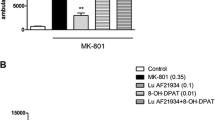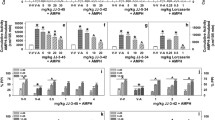Abstract
Introduction
5-HT2C agonists, by decreasing mesolimbic dopamine without affecting nigrostriatal dopamine, are predicted to have antipsychotic efficacy with low extrapyramidal side effects (EPS). Combining 5-HT2C agonists with low doses of existing antipsychotics could increase treatment efficacy while reducing treatment liabilities such as EPS (typical antipsychotics), and the propensity for weight gain (atypical antipsychotics).
Objectives
The objectives of these studies were to combine WAY-163909, a selective 5-HT2C agonist, with either the typical antipsychotic haloperidol, or the atypical antipsychotic clozapine, at doses that were ineffective on their own, with the expectation that a shift in potency in several rodent behavior models predictive of antipsychotic activity would occur.
Results and discussion
In mice, co-administration of either haloperidol, or clozapine, produced a significant leftward shift in the ability of WAY-163909 to block apomorphine-induced climbing behavior, without any affect on apomorphine-induced stereotypy or an increased propensity for catalepsy. In the rat-conditioned avoidance model, WAY-163909 was combined with either haloperidol or clozapine at doses that individually produced reductions in avoidance response on the order of 10%, while the combination of WAY-163909 and either of the antipsychotics resulted in a greater than 70% reduction in avoidance, with no evidence of response failures, or pharmacokinetic interaction.
Conclusion
Doses of either haloperidol or clozapine, that failed to antagonize an MK-801 induced deficit in prepulse inhibition, significantly attenuated the sensory gating deficit when combined with WAY-163909. Data support the notion that 5-HT2C receptor agonists, co-administered with other marketed antipsychotics, allow for dose sparing with a more favorable side-effect profile.







Similar content being viewed by others
References
Allison DB, Mentore JL, Mooseong H, Chander LP, Cappelleri JC, Infante MC, Weiden PJ (1999) Antipsychotic-induced weight gain: a comprehensive research synthesis. Am J Psychiatry 156:1686–1696
Antai-Otong D (2004) Metabolic effects associated with atypical antipsychotic medications. Perspectives in Psychiatric Care 40:70–72
Arnt J (1982) Pharmacological specificity of conditioned avoidance response inhibition in rats: inhibition by neuroleptics and correlation to dopamine receptor blockade. Acta Pharmacol Toxicol 51:321–329
Baptista T, De Mendoza S, Beaulieu S et al (2004) The metabolic syndrome during atypical antipsychotic drug treatment: mechanism and management. Metabolic Syndrome and Related Disorders 2:290–307
Browman KE, Komater VA, Curzon P, Rueter LE, Hancock AA, Decker MW, Fox GB (2004) Enhancement of prepulse inhibition of startle in mice by the H3 receptor antagonists thioperamide and ciproxifan. Behav Brain Res 153:69–76
Buchanan A (1992) A two-year prospective study of treatment compliance in patients with schizophrenia. Psychol Med 22:787–797
Casey DE (1996) Side effects of new antipsychotic agents. J Clin Psych 57(Suppl):s40–s45
Coyle JT, Tsai G, Goff D (2003) Converging evidence of NMDA receptor hypofunction in the pathophysiology of schizophrenia. Ann NY Acad Sci 1003:318–327
Costall B, Naylor RJ, Neumeyer (1975) Differences in the nature of stereotyped behaviour induced by apomorphine derivatives in the rat and in their actions in extrapyramidal and mesolimbic brain areas. Eur J Pharmacol 31:1–16
Costall B, Naylor RJ, Nohria V (1980) On the importance of mesolimbic mechanisms for the control of apomorphine induced climbing behaviour in the mouse. Br J Pharmacol 68:175P–176P
Cowen PJ, Sargent PA, Williams C, Goodall EM, Orlikov AB (1995) Hypophagic, endocrine and subjective responses to m-chlorophenylpiperazine in healthy men and women. Hum Psychopharmacol 10:385–391
Czobor P, Volavka J, Sheitman B, Lindenmayer JP, Citrome L, McEvoy J, Cooper TB, Chakos M, Lieberman JA (2002) Antipsychotic-induced weight gain and therapeutic response: a differential association. J Clin Pyschopharmacol 22:244–251
Di Giovanni G, Di Matteo V, Di Mascio M, Esposito E (2000) Preferential modulation of mesolimbic vs. nigrostriatal dopaminergic function by serotonin 2C/2B receptor agonists: a combined in vivo electrophysiological and microdialysis study. Synapse 35:53–61
Dunlop J, Sabb AL, Mazandarani H, Zhang J, Kalgaonkers S, Shukhina E, Sukoff S, Vogel RL, Stack G, Schechter L, Harrison BL, Rosenzweig-Lipson S (2005) WAY-163909 ((7bR,10aR)-1,2,3,4,8,9,10,10a-octahydro-7bH-cyclopenta-[b][1,4]diazepino[6,7,1hi]indole), a novel 5-hydroxytryptamine 2C receptor-selective agonist with anorectic activity. J Pharmacol Exp Ther 313:862–869
Dunlop J, Marquis K, Lim HK, Leung L, Kao J, Cheesman C, Rosenzweig-Lipson (2006) Pharmacological profile of the 5-HT2C receptor agonist WAY-163909; therapeutic potential in multiple indications. CNS Drug Reviews 12(3):167–176
Gerlach J (1999) The continuing problem of extrapyramidal symptoms: strategies for avoidance and effective treatment. J Clin Psychiatry 60(Suppl):s20–s23
Gervin M, Browne J, Garavan M, Roe C, Larkin C, Callaghan O (1999) Dysphoric subjective response to antipsychotics in schizophrenia: relationship to extrapyramidal side-effects and symptomatology. Eur Psychiatry 14:405–409
Geyer MA, Krebs-Thomson K, Braff DL, Swerdlow NR (2001) Pharmacological studies of prepulse inhibition models of sensorimotor gating deficits in schizophrenics: as decade in review. Psychopharmacology 156:117–154
Gleason SD, Shannon HE (1997) Blockade of phencyclidine-induced hyperlocomotion by olanzapine, clozapine and serotonin receptor subtype selective antagonists in mice. Psychopharmacology 129:79–84
Goff DC, Sullivan L, McEvoy JP, Meyer JM, Nasrallah HA, Daumit GL, Lamberti S, D’Agostino RB, Stroup TS, Davis S, Lieberman JA (2005) A comparison of ten-year cardiac risk estimates in schizophrenia patients from the CATIE study and matched controls. Schizophr Res 80(1):45–53
Hoffman DC, Donovan H (1995) Catalepsy as a rodent model for detecting antipsychotic drugs with extrapyramidal side effect liability. Psychopharmacology 120:128–133
Kapur S, Remington G (2001) Aytpical antipsychotics: new directions and challenges in the treatment of schizophrenia. Annu Rev Med 52:503–517
Kane J, Woerner MG, Lieberman J (1998) Tardive dyskinesia: prevalence, incidence and risk factors. J Clin Psychopharmacol 8:52S–62S
Koro CE, Fedder DO, L’Italien GJ, Weiss SS, Magder LS, Kreyenbuhl J, Rivicki DA, Buchanan RW (2002) Assessment of independent effect of olanzapine and risperidone on risk of diabetes among patients with schizophrenia: population based nested case-control study. BMJ 325:243–245
Leysen JE (2004) 5-HT2 receptors. Curr Drug Targ CNS Neurolog Disord 3:11–26
Lieberman JA, Stroup TS, McEvoy JP et al (2005) Effectiveness of antipsychotic drugs in patients with chronic schizophrenia. N Engl J Med 353(12):1209–1223
Marquis KL, Sabb AL, Logue SF, Brennan JA, Piesla MJ, Comery TA, Grauer SM, Ashby CR Jr, Nguyen HQ, Dawson LA, Barrett JE, Stack G, Meltzer HY, Harrison BL, Rosenzweig-Lipson S (2007) WAY-163909 ((7bR,10aR)-1,2,3,4,8,9,10,10a-octahydro-7bH-cyclopenta-[b][1,4]diazepino[6,7,1hi]indole): a novel 5-hydroxytryptamine 2C receptor-selective agonist with preclinical antipsychotic-like activity. J Pharmacol Exp Ther 320:486–496
McEvoy JP, Meyer JM, Nasrallah HA, Davis SM, Sullivan L, Meltzer HY, Hsiao J, Stroup TS, Lieberman JA (2005) Prevalence of the metabolic syndrome in patients with schizophrenia: baseline results from the Clinical Antipsychotic Trials of Intervention Effectiveness (CATIE) schizophrenia trial and comparisons with national estimates from NHANES III. Schizophr Res 80(1):19–32
Meltzer HY (2004) What’s atypical about atypical antipsychotic drugs. Curr Op in Pharmacol 4:53–57
Meyer JM (2001) Effects of atypical antipsychotics on weight and serum lipid levels. J Clin Psychiatry 62(Suppl):s27–s41
Millan MJ, Dekeyne A, Gobert A (1998) Serotonin 5-HT2C receptors tonically inhibit dopamine (DA) and noradrenaline (NA) but not 5-HT release in the frontal cortex in vivo. Neuropharmacol 37:953–955
Navailles S, De Deurwaerdere P, Spampinato U (2006) Clozapine and haloperidol differentially alter the constitutive activity of central serotonin2C receptors in vivo. Biological Psychiatry. 59(6):568–575
Nonogaki K, Strack AM, Dallman MF, Tecott LH (1998) Leptin-independent hyperphagia and Type 2 diabetes in mice with mutated serotonin 5-HT2C receptor gene. Nat Med 4(10):1152–1156
Roger SM, McCann SM, Kennedy SH (2001) Antipsychotic metabolic effects: diabetes mellitus and lipid abnormalities. Can J Psychiatry 46:273–280
Robinson D, Woerner MG, Alvir JM, Bilder R, Goldman R, Geisler S, Koreen A, Sheitman B, Chakos M, Mayerhoff D, Lieberman JA (1999) Predictors of relapse following response from a first episode of schizophrenia or schizoaffective disorder. Arch Gen Psych 56:241–247
Rosenzweig-Lipson S, Zhang J, Mazandarani H, Harrison BL, Sabb A, Sabalski J, Stack G, Welmaker G, Barrett JE, Dunlop J (2006) Antiobesity-like effects of the 5-HT2C receptor agonist WAY-161505. Brain Res 1073–1074:240–251
Rosenzweig-Lipson S, Sabb A, Stack G, Mitchell P, Lucki I, Malberg J, Grauer S, Brennan J, Cryan JF, Rizzo SJS, Dunlop J, Barrett JE, Marquis KL (2007) Antidepressant-like effects of the novel, selective, 5-HT2C receptor agonist WAY-163909 in rodents. Psychopharmacology 192(2):159–170
Shilliam CS, Dawson LA (2005) The effect of clozapine on extracellular dopamine levels in the shell subregion of the rat nucleus accumbens is reversed following chronic administration: comparison with a selective 5-HT(2C) receptor antagonist. Neuropsychopharmacol 30:372–380
Taylor DM, McAskill R (2000) Atypical antipsychotics and weight gain—a systematic review. Acta Psychiatrica Scandinavica 101:416–432
Van Gaal LF (2006) Long-term health considerations in schizophrenia: metabolic effects and the role of abdominal adiposity. Eur Neuropsychopharmacol 16:S142–S148
Van Putten T (1974) Why do schizophrenic patients refuse to take their drugs. Arch Gen Psych 31:67–72
Young JL, Zonana HV, Shepler L (1986) Medication non-compliance in schizophrenia: codification and update. Bull Am Acad Psych Law 14:105–122
Acknowledgments
The authors wish to thank Juan Mercado, Brian Ludwig, Tony Silverio, and Matthew Schoell for their excellent technical assistance in supporting the pharmacokinetic interaction studies.
Author information
Authors and Affiliations
Corresponding author
Rights and permissions
About this article
Cite this article
Grauer, S.M., Graf, R., Navarra, R. et al. WAY-163909, a 5-HT2C agonist, enhances the preclinical potency of current antipsychotics. Psychopharmacology 204, 37–48 (2009). https://doi.org/10.1007/s00213-008-1433-z
Received:
Accepted:
Published:
Issue Date:
DOI: https://doi.org/10.1007/s00213-008-1433-z




